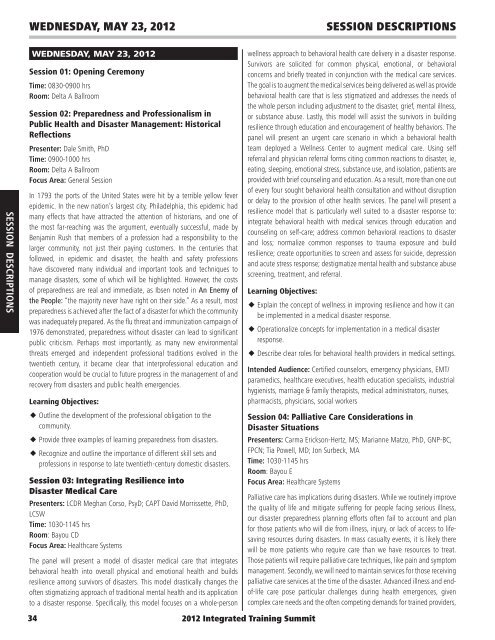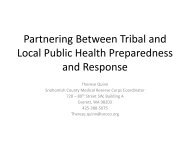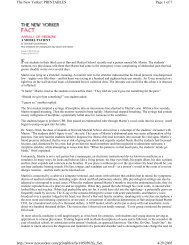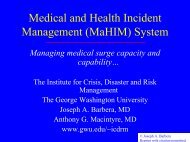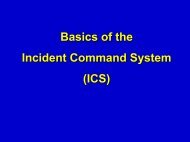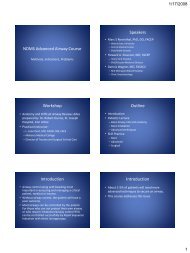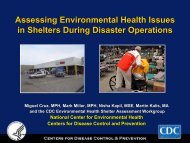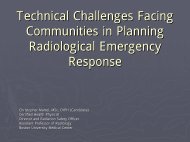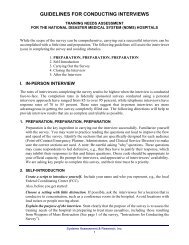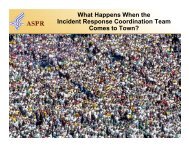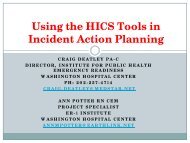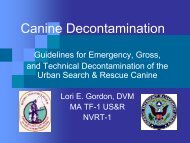wednesday, May 23, <strong>2012</strong>Session Descriptionssession DescriptionsWEDNESday, May 23, <strong>2012</strong>Session 01: Opening CeremonyTime: 0830-0900 hrsRoom: Delta A BallroomSession 02: <strong>Preparedness</strong> and Professionalism inPublic Health and Disaster Management: HistoricalReflectionsPresenter: Dale Smith, PhDTime: 0900-1000 hrsRoom: Delta A BallroomFocus Area: General SessionIn 1793 the ports of the United States were hit by a terrible yellow feverepidemic. In the new nation’s largest city, Philadelphia, this epidemic hadmany effects that have attracted the attention of historians, and one ofthe most far-reaching was the argument, eventually successful, made byBenjamin Rush that members of a profession had a responsibility to thelarger community, not just their paying customers. In the centuries thatfollowed, in epidemic and disaster, the health and safety professionshave discovered many individual and important tools and techniques tomanage disasters, some of which will be highlighted. However, the costsof preparedness are real and immediate, as Ibsen noted in An Enemy ofthe People: “the majority never have right on their side.” As a result, mostpreparedness is achieved after the fact of a disaster for which the communitywas inadequately prepared. As the flu threat and immunization campaign of1976 demonstrated, preparedness without disaster can lead to significantpublic criticism. Perhaps most importantly, as many new environmentalthreats emerged and independent professional traditions evolved in thetwentieth century, it became clear that interprofessional education andcooperation would be crucial to future progress in the management of andrecovery <strong>from</strong> disasters and public health emergencies.Learning Objectives:u Outline the development of the professional obligation to thecommunity.u Provide three examples of learning preparedness <strong>from</strong> disasters.u Recognize and outline the importance of different skill sets andprofessions in response to late twentieth-century domestic disasters.Session 03: Integrating Resilience intoDisaster Medical CarePresenters: LCDR Meghan Corso, PsyD; CAPT David Morrissette, PhD,LCSWTime: 1030-1145 hrsRoom: Bayou CDFocus Area: Healthcare Systems<strong>The</strong> panel will present a model of disaster medical care that integratesbehavioral health into overall physical and emotional health and buildsresilience among survivors of disasters. This model drastically changes theoften stigmatizing approach of traditional mental health and its applicationto a disaster response. Specifically, this model focuses on a whole-personwellness approach to behavioral health care delivery in a disaster response.Survivors are solicited for common physical, emotional, or behavioralconcerns and briefly treated in conjunction with the medical care services.<strong>The</strong> goal is to augment the medical services being delivered as well as providebehavioral health care that is less stigmatized and addresses the needs ofthe whole person including adjustment to the disaster, grief, mental illness,or substance abuse. Lastly, this model will assist the survivors in buildingresilience through education and encouragement of healthy behaviors. <strong>The</strong>panel will present an urgent care scenario in which a behavioral healthteam deployed a Wellness Center to augment medical care. Using selfreferral and physician referral forms citing common reactions to disaster, ie,eating, sleeping, emotional stress, substance use, and isolation, patients areprovided with brief counseling and education. As a result, more than one outof every four sought behavioral health consultation and without disruptionor delay to the provision of other health services. <strong>The</strong> panel will present aresilience model that is particularly well suited to a disaster response to:integrate behavioral health with medical services through education andcounseling on self-care; address common behavioral reactions to disasterand loss; normalize common responses to trauma exposure and buildresilience; create opportunities to screen and assess for suicide, depressionand acute stress response; destigmatize mental health and substance abusescreening, treatment, and referral.Learning Objectives:u Explain the concept of wellness in improving resilience and how it canbe implemented in a medical disaster response.u Operationalize concepts for implementation in a medical disasterresponse.u Describe clear roles for behavioral health providers in medical settings.Intended Audience: Certified counselors, emergency physicians, EMT/paramedics, healthcare executives, health education specialists, industrialhygienists, marriage & family therapists, medical administrators, nurses,pharmacists, physicians, social workersSession 04: Palliative Care Considerations inDisaster SituationsPresenters: Carma Erickson-Hertz, MS; Marianne Matzo, PhD, GNP-BC,FPCN; Tia Powell, MD; Jon Surbeck, MATime: 1030-1145 hrsRoom: Bayou EFocus Area: Healthcare SystemsPalliative care has implications during disasters. While we routinely improvethe quality of life and mitigate suffering for people facing serious illness,our disaster preparedness planning efforts often fail to account and planfor those patients who will die <strong>from</strong> illness, injury, or lack of access to lifesavingresources during disasters. In mass casualty events, it is likely therewill be more patients who require care than we have resources to treat.Those patients will require palliative care techniques, like pain and symptommanagement. Secondly, we will need to maintain services for those receivingpalliative care services at the time of the disaster. Advanced illness and endof-lifecare pose particular challenges during health emergences, givencomplex care needs and the often competing demands for trained providers,34<strong>2012</strong> Integrated Training Summit
wednesday, May 23, <strong>2012</strong>Session Descriptionsmateriel, and space. This session will present and compare existing nationalguidelines for health emergency response, focusing on issues related topalliative and end-of-life care. Special attention will be given to the surgecapacity planning needs of hospice and palliative care providers and toproviding tools for leveraging their expertise to maximize care for patientswith serious, advanced illness.Learning Objectives:u Discuss Health and Human Services (HHS) templates for states,emergency medical services (EMS) systems, hospitals, and individualclinicians to guide decision making when implementing crisisstandards of care that can be easily read, understood, and executedduring an incident.u Explain existing guidelines for scarce resource allocation and crisisstandards of care, and their implications for surge capacity planningfactors for hospice and palliative care providers.u Identify potential disaster scenarios that might be faced at the localand state level, requiring palliative care services.Intended Audience: Certified counselors, dentists, emergencyphysicians, EMT/paramedics, healthcare executives, health educationspecialists, marriage & family therapists, medical administrators, nurses,pharmacists, physicians, psychologists, social workersSession 05: Passing the Torch: Succession PlanningDone Right?Presenter: Teddy Rogers, MSA, NREMT-PTime: 1030-1145 hrsRoom: Delta CFocus Area: LeadershipOne of the primary tasks of any quality leader is the continual and progressivework around succession planning. <strong>The</strong>re are those who say a great leadermay not be replaceable, and then there are those who say a great leadershould have prepared for such a transition. <strong>The</strong> successful leader’s roleis to literally plan to be replaced! <strong>The</strong> welfare of any great organizationdepends upon this premise. <strong>The</strong> primary acts that a great leader performs toprepare for successful transitions are casting vision, planting and guardingthe organizational culture, and fostering an environment where subordinateleaders can perform in a fail-safe manner, free to make mistakes and learnwithout sinking the organization as a whole. This session will center onthese three primary acts that, if done correctly and proactively, will lay theframework for a successful transition in any organization. Finally, the greatleader must learn firsthand that the success or failure of such a transition liescompletly within. Ego management, overconfidence or lack of confidence,and personal motives and behaviors are all critical in any leadershiptransition. If you are in a leadership position, you have a job to do. Planto leave the day you are hired, because you will leave whether you wantto or not!Learning Objectives:u Describe the intrinsic value of performing the three acts of successionplanning offered in this course and how to do them.u Discuss the importance of looking within in order to successfully passthe torch. Ironically, what’s inside you will come out when you leave,like it or not.u Demonstrate the process of passing the torch!Intended Audience: Certified counselors, dentists, emergencyphysicians, EMT/paramedics, environmental health personnel, healthcareexecutives, health education specialists, industrial hygienists, marriage &family therapists, medical administrators, morticians, nurses, physicians,social workers, veterinariansSession 06: Chaplaincy Support for DisasterDeployment ResponsesPresenter: Catherine Witte, RPh, MDivTime: 1030-1145 hrsRoom: Delta DFocus Area: LeadershipAs stated by Dr. George Everly, Co-Founder and Chairman Emeritus of theInternational Critical Incident Stress Foundation, “It has been commonlyobserved that in times of crisis and disaster, many individuals seek outreligious or spiritual leaders,” but it it has only been within the last 10 or15 years that spiritual care has been formally integrated into many types ofdisaster response missions. <strong>The</strong> provision of spiritual and emotional supportin a timely and appropriate manner to those impacted by disasters has thebenefit of mitigating short and longer-term distress (emotionally, spiritually,and physically) for individual survivors, communities, first responders, andothers involved in providing disaster relief. Chaplains with specialized trainingtypically use various methods and approaches in providing spiritual careservices in disaster response, and examples of these will be discussed. Aswith other components within disaster response, spiritual care is a field thatis growing and adapting to most effectively meet the needs and challengesof diverse communities. Encouraging collaborative partnerships in providingspiritual care within communities and across agencies serving those in needwill be essential for the success of the overall disaster response mission.Learning Objectives:u Discuss a history and overview of spiritual care services as a formalcomponent in disaster response.u Define the role and function of chaplains and others providingspiritual care within the incident command and disaster responseoperation.u Describe planning, methods, and execution of spiritual care servicesas an integrated component of USPHS and other agency disasterresponse missions.Intended Audience: Certified counselors, emergency physicians, EMT/paramedics, healthcare executives, health education specialists, marriage& family therapists, medical administrators, morticians, nurses, physicians,social workers<strong>2012</strong> Integrated Training Summit 35session Descriptions
- Page 1 and 2: Leading from PreparednessThrough Re
- Page 3 and 4: Table of ContentsAmericans with Dis
- Page 5 and 6: Integrated Training Summit Partner
- Page 7 and 8: Focus area DescriptionsFocus Area D
- Page 9 and 10: Late Breakers & Early RisersTuesday
- Page 11 and 12: Handy Perforated Daily Agendas - De
- Page 13 and 14: Handy Perforated Daily Agendas - De
- Page 15 and 16: Handy Perforated Daily Agendas - De
- Page 17 and 18: Handy Perforated Daily Agendas - De
- Page 19 and 20: WorkshopDescriptions2012 Integrated
- Page 21 and 22: Monday, May 21, 2012Workshop Descri
- Page 23 and 24: MoNday, May 21, 2012Workshop Descri
- Page 25 and 26: MoNday, May 21, 2012Workshop Descri
- Page 27 and 28: Tuesday, May 22, 2012Workshop Descr
- Page 29 and 30: WEDNESday, May 23, 2012dMIS Worksho
- Page 31 and 32: ThurSday, May 23, 2012dMIS Workshop
- Page 33: SessionDescriptionssession Descript
- Page 37 and 38: wednesday, May 23, 2012Session Desc
- Page 39 and 40: wednesday, May 23, 2012u Provide ex
- Page 41 and 42: wednesday, May 23, 2012Session Desc
- Page 43 and 44: wednesday, May 23, 2012Session Desc
- Page 45 and 46: Thursday, May 24, 2012Session Descr
- Page 47 and 48: THURsday, May 24, 2012Session Descr
- Page 49 and 50: THURsday, May 24, 2012Session Descr
- Page 51 and 52: THURsday, May 24, 2012Session Descr
- Page 53 and 54: THURsday, May 24, 2012Session Descr
- Page 55 and 56: THURsday, May 24, 2012Session Descr
- Page 57 and 58: FRIday, May 25, 2012Session Descrip
- Page 59 and 60: Tuesday, May 22, 2012MRC WorkshopsM
- Page 61 and 62: Tuesday, May 22, 2012MRC WorkshopsL
- Page 63 and 64: Continuing Education InformationCon
- Page 65 and 66: Continuing Education InformationSes
- Page 67 and 68: Planning CommitteeDawn AnastasiaChe
- Page 69 and 70: PresentersBrian Abrahamson, BAGaylo
- Page 71 and 72: PresentersMary Massey, BSN, MA, MEP
- Page 73 and 74: Presenter DisclosuresAlliance betwe
- Page 75 and 76: 2012 Poster PresentationsMRCPoster
- Page 77 and 78: 2012 Poster PresentationsApplicatio
- Page 79 and 80: 2012 Poster PresentationsCollaborat
- Page 81 and 82: 2012 Poster PresentationsEducation
- Page 83 and 84: 2012 Poster PresentationsSpecial Co
- Page 85 and 86:
Integrated Training Summit Acronym


